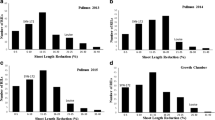Abstract
Wild relatives of our present crop plants, although agronomically undesirable, may have acquired many desirable stress-resistant characteristics as a result of their long exposure to nature’s stresses. Early U.S. collection activities for wild forms ofBeta were conducted by George H. Coons (USDA-ARS) in 1925 and 1935. These collections were mainly wild forms of the sectionBeta, with major emphasis on leaf spot (Cercospora beticola) resistance. Little was done with this collection until 1976, when John McFarlane (USDA-ARS) transferred it to Salinas, California, to regenerate seed for preservation. Unfortunately, about half of the collection had lost germinability. Immunity to Rhizomania, a devastating root disease discovered in California in 1983, was discovered in several accessions of the Coons’ collection by E. D. Whitney. Interestingly, these same accessions subsequently have been found to exhibit Erwinia root rot resistance, sugar beet root maggot tolerance, and moderate leaf spot resistance. The value of wild germplasm is not always apparent immediately. Needs change and the value of wild germplasm may not be realized for years.
Résumé
Wilde Verwandte unserer gegenwaertigen Kulturpflanzen, obwohl landwirtschaftlich unerwuenscht, moegen viele erwuenschte Stress-widerstandsfaehige Eigenschaften angenommen haben, als eine Folge ihres langen Ausgesetztseins gegen die Stresse der Natur. Fruehe U.S. Sammulungen von wilden Beta Formen wurden von George H. Coons (USDA-ARS) in 1925 und 1935 durchgefuehrt. Diese Sammlungen waren hauptsaechlich wilde Formen der AbteilungBeta mit Hauptbetonung auf Blattfleck Widerstandsfaehigkeit (Cercospora beticola). Wenig wurde mit dieser Summlung bis 1976 getan, wo John McFarlane (USDA-ARS) sie nach Salinas, CA ueberwies, um Saatgut fuer die Erhaltung zu erneuern. Leider hatte die Haelfte der Sammlung ihre Keimfaehigkeit verloren. Unempfaenglichkeit gegen Rhizomania, eine verheerende Wurzelkrankheit, 1983 in Californien entdeckt, wurde in mehreren Anschaffungen der Coons’ Sammlung von E. D. Whitney entdeckt. Interessanterweise zeigten sich anschliessend in diesen gleichen Anschaffungen Erwinia Wurzelfauele Widerstandsfaehigkeit, Zuckerrueben Wurzen Made Toleranz und gemaessigte Blattfleckenkrankheit Widerstandsfaehigkeit. Der Wert der wilden Zellenplasma ist nicht immer sofort sichtbar. Beduerfnisse aendern sich, un der Wert der wilden Zellenplasma mag fuer Jahre noch nicht erkannt sein.
Similar content being viewed by others
Literature Cited
Biancardi, E., and M. Biaggi. 1979.Beta maritima L. in the Po Delta. Pages 183-185in ATTI Con Vagno Tecnico Intemazionale Sulla Bieticoltura, in Commerorazione Di Ottavio Munerati. Bologna, Italy.
Clark, M. F., and A. N. Adams. 1977. Characteristics of the microplate method of enzyme-linked immunosorbent assay for detection of plant viruses. J. Gen. Virol. 34:475–483.
Coons, G. H. 1975. Interspecific hybrids betweenBeta vulgaris L. and wild species ofBeta. J. Amer. Soc. Sugar Beet Technol. 18:281–306.
Doney, D. L. 1985. Origin, distribution and collection of sugarbeet and its wild relatives. Sugarbeet Res. & Extens. Rep. 16:292–296.
Duffus, J. E., E. D. Whitney, R. C. Larson, H. Y. Liu, and R. T. Lewellen. 1984. First report in Western Hemisphere of Rhizomania of sugarbeet caused by beet necrotic yellow vein virus. Plant Dis. 68:251.
Fay, D. H. 1986. Host plant resistance to the sugarbeet root maggot,Tetanops myopaeformis (Roder). Master’s thesis, North Dakota State University.
Lewellen, R. T., I. O. Skoyen, and A. W. Erichsen. 1987. Breeding sugarbeet for resistance to Rhizomania: evaluation of host-plant reaction and selection for and inheritance of resistance. Pages 139-156in 50th Winter Congress, IIRB, Brussels, Belgium, 11–12 Feb. 1987.
Smith, G. A., and J. O. Gaskill. 1970. Inheritance of resistance to Cercospora leaf spot in sugarbeet. J. Amer. Soc. Sugar Beet Technol. 16:172–180.
Whitney, E. D. 1986. Correlations among greenhouse tests and between field and laboratory evaluations for beet necrotic yellow vein virus (BNYVV) resistance inBeta maritima. Phytopathology 76:1074.
—. 1989. Identification, distribution, and testing for resistance to Rhizomania inBeta maritima. Plant Dis. 73:287–290.
—, and R. T. Lewellen. 1977. Bacterial vascular necrosis and rot of sugar beet: effect on cultivars and quality. Phytopathology 67:912–916.
—, and R. T. Lewellen. 1978. Bacterial vascular necrosis and rot of sugarbeet: genetic vulnerability and selecting for resistance. Phytopathology 68:657–661.
Zossimovitch, V. P. 1940. Wild species and origin of cultivated beets. Pages 17–89in Biology, genetics, and selection of sugar beets. All-Union Scientific Institute of the Sugar Industry, Kiev, U.S.S.R.
Author information
Authors and Affiliations
Rights and permissions
About this article
Cite this article
Doney, D.L., Whitney, E.D. Genetic enhancement in beta for disease resistance using wild relatives: A strong case for the value of genetic conservation. Econ Bot 44, 445–451 (1990). https://doi.org/10.1007/BF02859778
Received:
Accepted:
Issue Date:
DOI: https://doi.org/10.1007/BF02859778




